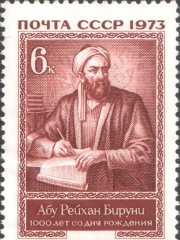
The Most Famous
MATHEMATICIANS from Uzbekistan
This page contains a list of the greatest Uzbekistani Mathematicians. The pantheon dataset contains 1,004 Mathematicians, 1 of which were born in Uzbekistan. This makes Uzbekistan the birth place of the 46th most number of Mathematicians behind Australia, and Georgia.
Top 1
The following people are considered by Pantheon to be the most legendary Uzbekistani Mathematicians of all time. This list of famous Uzbekistani Mathematicians is sorted by HPI (Historical Popularity Index), a metric that aggregates information on a biography's online popularity.

1. Al-Biruni (973 - 1048)
With an HPI of 83.73, Al-Biruni is the most famous Uzbekistani Mathematician. His biography has been translated into 94 different languages on wikipedia.
Abu Rayhan Muhammad ibn Ahmad al-Biruni, known as al-Biruni (c. 973 – c. 1050) was a Khwarazmian Iranic scholar and polymath during the Islamic Golden Age. He has been called variously "Father of Comparative Religion", "Father of modern geodesy", Founder of Indology and the first anthropologist. Al-Biruni was well versed in physics, mathematics, astronomy, and natural sciences; he also distinguished himself as a historian, chronologist, and linguist. He studied almost all the sciences of his day and was rewarded abundantly for his tireless research in many fields of knowledge. Royalty and other powerful elements in society funded al-Biruni's research and sought him out with specific projects in mind. Influential in his own right, al-Biruni was himself influenced by the scholars of other nations, such as the Greeks, from whom he took inspiration when he turned to the study of philosophy. A gifted linguist, he was conversant in Khwarezmian, Persian, Arabic, and Sanskrit, and also knew Greek, Hebrew, and Syriac. He spent much of his life in Ghazni, then capital of the Ghaznavids, in modern-day central-eastern Afghanistan. In 1017, he travelled to the Indian subcontinent and wrote a treatise on Indian culture entitled Tārīkh al-Hind ("The History of India"), after exploring the Hindu faith practiced in India. He was, for his time, an admirably impartial writer on the customs and creeds of various nations, his scholarly objectivity earning him the title al-Ustadh ("The Master") in recognition of his remarkable description of early 11th-century India.
People
Pantheon has 1 people classified as Uzbekistani mathematicians born between 973 and 973. Of these 1, none of them are still alive today. The most famous deceased Uzbekistani mathematicians include Al-Biruni.

